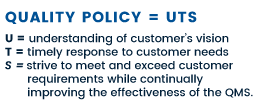Digital Product Definition | Model Based Definition Audits
The purpose of the Digital Product Definition (DPD) / Model Based Definition (MBD) Audit is to verify that procedures are established in the Quality Assurance Plan that identifies how control of digital data is maintained from receipt through end item acceptance. The process must ensure the original authority datasets are secure, backed up, not alterable, and only the appropriate people have write access to part programs and inspection datasets.
The scope of the procedure applies to digital data used to fabricate, assemble, install, or inspect product.
The typical MBD / DPD assessment is split into 4 sections.
- Section A of the checklist is used to perform a basic Digital Product Definition (DPD) capability verification.
- Section B is used to perform Model Based Definition (MBD) capability verification.
- Section C is used for Coordinate Measurement System (CMS) capability verification.
- Section D is used to perform Plotter capability verification.
The checklists for Sections B, C & D are designed to build upon the basic DPD capability assessment from Section A, therefore, Section A must be performed prior to performing assessment for CMS or MBD. The MBD, CMS and Plotting sections may not be applicable if the supplier does not require these capabilities for tooling or production use.
The broad definition of DPD/MBD information include:
- The CAD model and fully dimensioned 2D drawing sheets.
- The CAD model and simplified or reduced content 2D drawing sheets.
- The 3D model and the engineering requirements displayed as text within the 3D viewing area of the model, as well as the remaining engineering requirements (in 2D form – notes list, part lists, etc.).
The application of this DPD/MBD audit is required for when OEM DPD data is used in the Supplier’s computing systems and procedures to produce product(s) or digital data for product acceptance (including accountability of tooling and tooling used for inspection).
These requirements provide the basis for suppliers to create and implement plans, user level procedures and process documentation for the use of DPD/MBD. The supplier shall have defined and reliable configuration management and Quality Assurance (QA) processes in place reflecting its methods of operation. Supplier is required to maintain integrity of DPD/MBD through all operations when new DPD/MBD methods are deployed. It is expected that suppliers will utilize DPD/MBD processes to continuously improve the quality of delivered product.
Since 1973, we have been a dedicated partner to OEMs and their suppliers in the aerospace, defense and other industries. Contact us today for more information on our quality management system audit services.




